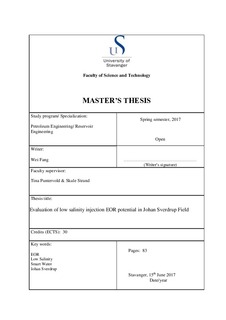| dc.description.abstract | Low salinity waterflooding is an EOR method that doesn’t get mentioned as much as other EOR methods in the current oil industry, but its recognition has been raised in the last few years and BP is also using their own low salinity technology for the whole Clair Ridge Field, UK. As the attention of this method has increased, many more research has been done in the last decade for determining the EOR mechanism that happens when injecting low saline brine into high saline formation brine. The exact mechanism is yet to be concluded, however, EOR effect that happens by this technique is believed to be wettability alteration. In this case, mixed wetting due to crude oil adsorption is essential for achieving an EOR effect. This mechanism is dependent on a CBR system that promotes adsorption, injecting low salinity water would then cause wettability alteration in the reservoir, resulting to a more water-wet state in the formation. If the reservoir lacks adsorption onto the rock formation, EOR effect would most likely not occur since it would be too water-wet initially.
This thesis focuses on evaluating the EOR potential by injecting low salinity brine into the Johan Sverdrup Field. Many papers and sources has been used to find the EOR possibility in the field. As the field is still under development, there are lack of information, such as certain reservoir property values, and thorough evaluation is hard to conduct due to this factor. However, a simplified evaluation could be done by analyzing the low salinity waterflooding mechanism with properties from Johan Sverdrup Field. Research result from the field showed that many of the conditions for a successful EOR effect is met. Polar component in crude oil, divalent cations in formation water, and clay in rock formation are all present. Considering the mentioned factors together with a not too high temperature in the reservoir would promote the adsorption of crude oil onto clay surface, and a mixed wet state is created in the reservoir. Furthermore, a smart way of choosing the water composition for the injected brine is more important than to simply reducing the salinity, as the composition is seen as more crucial than the salinity difference between injected brine and formation water. Considering all the mentioned factors, Johan Sverdrup Field has great EOR potential by injecting low salinity fluid for displacing extra amount of oil in the reservoir, and increase of microscopic sweep efficiency occurs due to wettability alteration from mixed wetting to a more water-wet state. | nb_NO |

